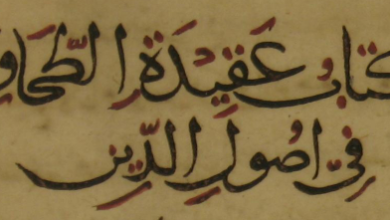THE EXPLANATION OF “FOOT” IN RELATION TO THE HELL-FIRE ACCORDING TO IMAMS AL-BAYHAQĪ (d. 458 AH) AND AL-KHAṬṬĀBĪ (d. 388 AH)
In his seminal work “Kitāb al-Asmāʾ wa-l-Ṣifāt” (The Book of Divine Names and Attributes), the distinguished Shāfiʿī jurist and hadith master (muḥaddith) Abū Bakr Aḥmad ibn al-Ḥussain al-Bayhaqī (d. 458/1066) presented a detailed analysis of traditions (aḥādīth) that mention “foot” in relation to Hell-fire. Al-Bayhaqī’s exposition is particularly noteworthy for its incorporation of the exegetical insights of Abū Sulaymān al-Khaṭṭābī (d. 388/998), a preeminent scholar renowned for authoring the first known commentary on Ṣaḥīḥ al-Bukhārī.
The significance of this analysis lies in its methodological approach to understanding problematic hadith texts (mushkil al-ḥadīth), particularly those that might superficially suggest anthropomorphic attributes. Both scholars demonstrate sophisticated engagement with:
1. Classical Arabic linguistics
2. Established principles of hadith interpretation
3. Theological considerations
4. Metaphorical usage in Arabic literary tradition
Their collaborative analysis, with al-Bayhaqī building upon al-Khaṭṭābī’s foundational work, represents a significant contribution to Islamic theological discourse and hermeneutical methodology. This scholarly exchange exemplifies the intellectual rigour applied to textual interpretation in classical Islamic scholarship during the formative period of Islamic theological development.
Quotes with translation (the Arabic is also available here – https://app.turath.io/book/9270?page=809):
٧٥٦ – أَخْبَرَنَا أَبُو عَبْدِ اللَّهِ الْحَافِظُ، أنا أَبُو الْفَضْلِ بْنُ إِبْرَاهِيمَ، نا أَحْمَدُ بْنُ سَلَمَةَ، نا مُحَمَّدُ بْنُ رَافِعٍ، نا شَبَابَةُ بْنُ سَوَّارٍ، حَدَّثَنِي وَرْقَاءُ، عَنْ أَبِي الزِّنَادِ، عَنِ الْأَعْرَجِ، عَنْ أَبِي هُرَيْرَةَ، عَنِ النَّبِيِّ ﷺ، فَذَكَرَ الْحَدِيثَ بِنَحْوٍ مِنْ حَدِيثِ هَمَّامِ بْنِ مُنَبِّهٍ إِلَّا أَنَّهُ قَالَ: «⦗١٩٢⦘ وَسَقَطُهُمْ وَعَجَزُهُمْ» وَانْتَهَى حَدِيثُهُ عِنْدَ قَوْلِهِ: «وَيُزْوَى بَعْضُهَا إِلَى بَعْضٍ»
756 – Abū ʿAbdillāh al-Ḥāfiẓ informed us, Abū al-Faḍl ibn Ibrāhīm informed us, Aḥmad ibn Salama informed us, Muḥammad ibn Rāfiʿ informed us, Shabāba ibn Sawwār informed us, Warqāʾ narrated to me, from Abū al-Zinād, from al-Aʿraj, from Abū Hurayra, from the Prophet ﷺ, and he mentioned the hadith similar to the hadith of Hammām ibn Munabbih except that he said: “[192] their lowly ones and their weak ones,” and his hadith ended at his saying: “and some of it will be joined to others.”
رَوَاهُ مُسْلِمٌ فِي الصَّحِيحِ عَنْ مُحَمَّدِ بْنِ رَافِعٍ، وَبِمَعْنَاهُ رَوَاهُ أَبُو صَالِحٍ عَنْ أَبِي سَعِيدٍ الْخُدْرِيِّ عَنِ النَّبِيِّ ﷺ مِنْ غَيْرِ إِضَافَةٍ، فَقَالَ: «حَتَّى يَضَعَ فِيهَا قَدَمًا»
Muslim narrated it in his Ṣaḥīḥ from Muḥammad ibn Rāfiʿ, and Abū Ṣāliḥ narrated it with similar meaning from Abū Saʿīd al-Khudrī from the Prophet ﷺ without attribution, saying: “until He places in it a foot.”
قَالَ أَبُو سُلَيْمَانَ الْخَطَّابِيُّ ﵀: «فَيُشْبِهُ أَنْ يَكُونَ مَنْ ذَكَرِ الْقَدَمَ وَالرِّجْلَ، وَتَرَكِ الْإِضَافَةِ إِنَّمَا تَرَكَهَا تَهَيُّبًا لَهَا، وَطَلَبًا لِلسَّلَامَةِ مِنْ خَطَأِ التَّأْوِيلِ فِيهَا، وَكَانَ أَبُو عُبَيْدٍ، وَهُوَ أَحَدُ أَئِمَّةِ أَهْلِ الْعِلْمِ، يَقُولُ: نَحْنُ نَرْوِي هَذِهِ الْأَحَادِيثَ وَلَا نُرِيغُ لَهَا الْمَعَانِيَ»
Abū Sulaymān al-Khaṭṭābī (may Allah have mercy on him) said: “It appears that those who mentioned the foot and the leg, and left out the attribution, only did so out of reverence for it, and seeking safety from error in its interpretation [taʾwīl]. And Abū ʿUbayd (al-Qāsim ibn Sallām al-Harawī, d. 224 AH), who was one of the leading scholars of knowledge, used to say: ‘We narrate these hadiths but we do not seek out their meanings.'” (1)
قَالَ أَبُو سُلَيْمَانَ: «وَنَحْنُ أَحْرَى بِأَنْ لَا نَتَقَدَّمَ فِيمَا تَأَخَّرَ عَنْهُ مَنْ هُوَ أَكْثَرُ عِلْمًا وَأَقْدَمُ زَمَانًا وَسِنًّا، وَلَكِنَّ الزَّمَانَ الَّذِي نَحْنُ فِيهِ قَدْ صَارَ أَهْلُهُ حِزْبَيْنِ: مُنْكِرٌ لِمَا يُرْوَى مِنْ نَوْعِ هَذِهِ الْأَحَادِيثِ رَأْسًا، وَمُكَذِّبٌ بِهِ أَصْلًا، وَفِي ذَلِكَ تَكْذِيبُ الْعُلَمَاءِ الَّذِينَ رَوَوْا هَذِهِ الْأَحَادِيثَ وَهُمْ أَئِمَّةُ الدِّينِ وَنَقَلَةُ السُّنَنِ، وَالْوَاسِطَةُ بَيْنَنَا وَبَيْنَ رَسُولِ اللَّهِ ﷺ
Abū Sulaymān said: “We are more worthy of not advancing in matters from which those who had more knowledge and were earlier in time and age held back. However, the people of our time have become two factions: one that completely denies what is narrated of these types of hadiths, and utterly rejects them, and in doing so they are rejecting the scholars who narrated these hadiths who are the leaders of the religion and transmitters of the traditions (al-Sunan), and the intermediaries between us and the Messenger of Allah ﷺ.”
وَالطَّائِفَةُ الْأُخْرَى مُسَلِّمَةٌ لِلرِّوَايَةِ فِيهَا ذَاهِبَةٌ فِي تَحْقِيقِ الظَّاهِرِ مِنْهَا مَذْهَبًا يَكَادُ يُفْضِي بِهِمْ إِلَى الْقَوْلِ بِالتَّشْبِيهِ وَنَحْنُ نَرْغَبُ عَنِ الْأَمْرَيْنِ مَعًا، وَلَا نَرْضَى بِوَاحِدٍ مِنْهُمَا مَذْهَبًا
“And the other group accepts the narration but goes so far in affirming their apparent [ẓāhir] meaning that it almost leads them to anthropomorphism [tashbīh]. We reject both approaches and are not satisfied with either of them as a methodology (Madhhab).”
فَيَحِقُّ عَلَيْنَا أَنْ نَطْلُبَ لِمَا يَرِدُ مِنْ هَذِهِ الْأَحَادِيثِ إِذَا صَحَّتْ مِنْ طَرِيقِ النَّقْلِ وَالسَّنَدِ، ⦗١٩٣⦘ تَأْوِيلًا يَخْرُجُ عَلَى مَعَانِي أُصُولِ الدِّينِ، وَمَذَاهِبِ الْعُلَمَاءِ، وَلَا نُبْطِلُ الرِّوَايَةَ فِيهَا أَصْلًا، إِذَا كَانَتْ طُرُقُهَا مُرْضِيَّةً وَنَقَلَتُهَا عُدُولًا
“Therefore, it is incumbent upon us to seek for these hadiths, when they are authentic in their transmission and chain, [193] an interpretation [taʾwīl] that aligns with the meanings of the fundamentals of religion and the methodologies of the scholars, and we do not invalidate their narration completely, when their paths of transmission are satisfactory and their transmitters are upright.”
قَالَ أَبُو سُلَيْمَانَ: وَذِكْرُ الْقَدَمِ هَهُنَا يَحْتَمِلُ أَنْ يَكُونَ الْمُرَادُ بِهِ: مَنْ قَدَّمَهُمُ اللَّهُ لِلنَّارِ مِنْ أَهْلِهَا، فَيَقَعُ بِهِمُ اسْتِيفَاءُ عَدَدِ أَهْلِ النَّارِ
Abū Sulaymān said: “The mention of the foot here could possibly mean: those whom Allah has predetermined for Hell from among its people, and through them the number of the people of Hell will be completed.”
وَكُلُّ شَيْءٍ قَدَّمْتُهُ فَهُوَ قَدَمٌ، كَمَا قِيلَ لِمَا هَدَمْتُهُ: هَدْمٌ، وَلِمَا قَبَضْتُهُ: قَبْضٌ، وَمِنْ هَذَا قَوْلُهُ ﷿: ﴿أَنَّ لَهُمْ قَدَمَ صِدْقٍ عِنْدَ رَبِّهِمْ﴾ [يونس: ٢] أَيْ مَا قَدَّمُوهُ مِنَ الْأَعْمَالِ الصَّالِحَةِ
“Everything you put forward is a ‘qadam’ (precedent), just as what you demolish is called ‘hadm’ (demolition), and what you grasp is called ‘qabḍ’ (grasp). This is similar to Allah’s saying: ‘That they have a precedent [qadam] of truthfulness with their Lord’ [Yūnus: 2], meaning what they have put forward of righteous deeds.”
وَقَدْ رُوِيَ مَعْنَى هَذَا عَنِ الْحَسَنِ، وَيُؤَيِّدُهُ قَوْلُهُ فِي الْحَدِيثِ: «وَأَمَّا الْجَنَّةُ فَإِنَّ اللَّهَ يُنْشِئُ لَهَا خَلْقًا»، فَاتَّفَقَ الْمَعْنَيَانِ أَنَّ كُلَّ وَاحِدَةٍ مِنَ الْجَنَّةِ وَالنَّارِ تُمَدُّ بِزِيَادَةِ عَدَدٍ يَسْتَوْفِي بِهَا عِدَّةَ أَهْلِهَا، فَتَمْتَلِئُ عِنْدَ ذَلِكَ
“This meaning has been narrated from al-Ḥasan, and it is supported by his saying in the hadith: ‘As for Paradise, Allah will create for it a new creation.’ Thus the two meanings agree that each of Paradise and Hell will be extended with an increase in numbers that will fulfill the count of their inhabitants, and they will become full at that point.”
قَالَ الشَّيْخُ أَحْمَدُ: وَفِيمَا كَتَبَ إِلَيَّ أَبُو نَصْرِ بْنُ قَتَادَةَ مِنْ كِتَابِ أَبِي الْحَسَنِ بْنِ مَهْدِيٍّ الطَّبَرِيِّ حِكَايَةً عَنِ النَّضْرِ بْنِ شُمَيْلٍ أَنَّ مَعْنَى قَوْلِهِ: «حَتَّى يَضَعَ الْجَبَّارُ فِيهَا قَدَمَهُ» أَيْ مَنْ سَبَقَ فِي عِلْمِهِ أَنَّهُ مِنْ أَهْلِ النَّارِ
Shaykh Aḥmad (al-Bayhaqī) said: “In what Abū Naṣr ibn Qatāda wrote to me from the book of Abū al-Ḥasan ibn Mahdī al-Ṭabarī, relating from al-Naḍr ibn Shumayl (d. 204 AH), that the meaning of his saying ‘until the Compeller places His foot in it’ means those who were predetermined in His knowledge to be among the people of Hell.”
قَالَ أَبُو سُلَيْمَانَ: قَدْ تَأَوَّلَ بَعْضُهُمُ الرِّجْلَ عَلَى نَحْو مِنْ هَذَا، قَالَ: وَالْمُرَادُ بِهِ اسْتِيفَاءُ عَدَدِ الْجَمَاعَةِ الَّذِينَ اسْتُوجِبُوا دُخُولَ النَّارِ
Abū Sulaymān said: “Some have interpreted [taʾawwala] the word ‘leg’ in a similar manner, saying: What is meant by it is the completion of the number of the group who have deserved to enter the Fire.”
قَالَ: وَالْعَرَبُ تُسَمِّي جَمَاعَةَ الْجَرَادِ رِجْلًا كَمَا سَمَّوْا جَمَاعَةَ الظِّبَاءِ سِرْبًا وَجَمَاعَةَ النَّعَامِ خَيْطًا، وَجَمَاعَةَ الْحَمِيرِ عَانَةً، قَالَ: وَهَذَا وَإِنْ كَانَ اسْمًا خَاصًّا لِجَمَاعَةِ الْجَرَادِ، فَقَدْ يُسْتَعَارُ لِجَمَاعَةِ النَّاسِ عَلَى سَبِيلِ التَّشْبِيهِ
He said: “The Arabs call a group of locusts ‘rijl’ (leg), just as they called a group of gazelles ‘sirb’, a group of ostriches ‘khayṭ’, and a group of donkeys ‘ʿāna’. He said: And even though this is a specific term for a group of locusts, it can be metaphorically used for a group of people by way of simile.”
وَالْكَلَامُ الْمُسْتَعَارُ وَالْمَنْقُوُلُ مِنْ مَوْضِعِهِ كَثِيرٌ، وَالْأَمْرُ فِيهِ عِنْدَ أَهْلِ اللُّغَةِ مَشْهُورٌ
“Metaphorical speech and words transferred from their original context are numerous, and this matter is well-known among the people of language.”
قَالَ أَبُو سُلَيْمَانَ ﵀: وَفِيهِ وَجْهٌ آخَرُ، وَهُوَ أَنَّ هَذِهِ الْأَسْمَاءَ أَمْثَالٌ يُرَادُ بِهَا إِثْبَاتُ مَعَانٍ لَا حَظَّ لِظَاهِرِ الْأَسْمَاءِ فِيهَا مِنْ طَرِيقِ الْحَقِيقَةِ، وَإِنَّمَا أُرِيدَ بِوَضْعِ الرِّجْلِ عَلَيْهَا نَوْعٌ مِنَ الزَّجْرِ لَهَا وَالتَّسْكِينُ مِنْ غَرَبِهَا
Abū Sulaymān (may Allah have mercy on him) said: “There is another aspect to this, which is that these names are metaphors intended to establish meanings in which the apparent [ẓāhir] meaning of the names has no literal [ḥaqīqī] share. Rather, what is meant by placing the leg upon it is a type of restraint and calming of its intensity.”
كَمَا ⦗١٩٤⦘ يَقُولُ الْقَائِلُ لِلشَّيْءِ يُرِيدُ مَحْوَهُ وَإِبْطَالَهُ: جَعَلْتُهُ تَحْتَ رِجْلَيَّ، وَوَضَعْتُهُ تَحْتَ قَدَمَيَّ
[194] Just as one says about something they want to erase or nullify: “I put it under my feet,” or “I placed it under my steps.”وَخَطَبَ رَسُولُ اللَّهِ ﷺ عَامَ الْفَتْحِ فَقَالَ: «أَلَا إِنَّ كُلَّ دَمِ وَمَأْثُرَةٍ فِي الْجَاهِلِيَّةِ فَهُوَ تَحْتَ قَدَمَيَّ هَاتَيْنِ إِلَّا سِقَايَةَ الْحَاجِّ وَسِدَانَةَ الْبَيْتِ»
And the Messenger of Allah ﷺ gave a sermon in the year of the conquest saying: “Behold, every blood feud and tradition from the pre-Islamic period is under these two feet of mine, except for providing water for the pilgrims and the custodianship of the House.”
يُرِيدُ مَحْوَ تِلْكَ الْمَآثِرِ وَإِبْطَالِهَا، وَمَا أَكْثَرُ مَا تَضْرِبُ الْعَرَبُ الْأَمْثَالَ فِي كَلَامِهَا بِأَسْمَاءِ الْأَعْضَاءِ، وَهِيَ لَا تُرِيدُ أَعْيَانَهَا، كَمَا تَقُولُ فِي الرَّجُلِ يَسْبِقُ مِنْهُ الْقَوْلُ أَوِ الْفِعْلُ ثُمَّ يَنْدَمُ عَلَيْهِ: قَدْ سُقِطَ فِي يَدِهِ؛ أَيْ نَدِمَ
He meant the erasure and nullification of those traditions. How often do the Arabs strike metaphors in their speech using names of body parts, while not intending their literal meanings, as when they say about a person who hastens to speak or act and then regrets it: “It fell in his hand,” meaning he regretted it.
وَكَقَوْلِهِمْ: رَغِمَ أَنْفُ الرَّجُلِ، إِذَا ذُلَّ. وَعَلَا كَعْبُهُ إِذَا جَلَّ. وَجَعَلْتُ كَلَامَ فُلَانٍ دُبُرَ أُذُنِي، وَجَعَلْتُ يَا هَذَا حَاجَتِي بِظَهْرٍ، وَنَحْوُهَا مِنْ أَلْفَاظِهِمُ الدَّائِرَةِ فِي كَلَامِهِمْ
And like their saying: “His nose was rubbed in the dust,” when someone is humiliated. And “His heel was elevated,” when someone becomes important. And “I put so-and-so’s words behind my ear,” and “O you, I put my need behind my back,” and similar expressions that circulate in their speech.
وَكَقَوْلِ امْرِئِ الْقَيْسِ فِي وَصْفِ طُولِ اللَّيْلِ:
[البحر الطويل]فَقُلْتُ لَهُ لَمَّا تَمَطَّى بِصُلْبِهِ … وَأَرْدَفَ أَعْجَازًا وَنَاءَ بِكَلْكَلِ
And like the saying of Imruʾ al-Qays in describing the length of night:
[In the meter of al-Ṭawīl]“So I said to it when it stretched out its spine,
And followed with its rear parts and pressed down with its chest”
وَلَيْسَ هُنَاكَ صُلْبٌ، وَلَا عَجُزٌ، وَلَا كَلْكَلٌ؛ وَإِنَّمَا هِيَ أَمْثَالٌ ضَرَبَهَا لِمَا أَرَادَ مِنْ بَيَانِ طُولِ اللَّيْلِ وَاسْتِقْصَاءِ الْوَصْفِ لَهُ، فَقَطَّعَ اللَّيْلَ تَقْطِيعَ ذِي أَعْضَاءٍ مِنَ الْحَيَوَانِ
And there is no actual spine, nor rear parts, nor chest; rather these are metaphors he struck for what he intended in describing the length of night and giving a thorough description of it, so he divided the night as one would divide the parts of an animal.
وَقَدْ تَمَطَّى عِنْدَ إِقْبَالِهِ وَامْتَدَّ بَعْدُ بِدِوَامِ رُكُودِهِ، وَطُولِ سَاعَاتِهِ، وَقَدْ تُسْتَعْمَلُ الرِّجْلُ أَيْضًا فِي الْقَصْدِ لِلشَّيْءِ وَالطَّلَبِ لَهُ عَلَى سَبِيلِ جِدٍّ وَإِلحَاحٍ، يُقَالُ: قَامَ فُلَانٌ فِي هَذَا الْأَمْرِ عَلَى رِجْلٍ، وَقَامَ عَلَى سَاقٍ إِذَا جَدَّ فِي الطَّلَبِ، وَبَالَغَ فِي السَّعْيِ
It stretched at its coming and extended afterwards through its continuous stillness and the length of its hours. And ‘leg’ can also be used to indicate intention for something and seeking it with seriousness and persistence. It is said: “So-and-so stood on one leg in this matter,” and “stood on a shin” when he became serious in seeking and went to great lengths in pursuit.
وَهَذَا الْبَابُ كَثِيرُ التَّصَرُّفِ
And this category has many variations.
فَإِنْ قِيلَ: فَهَلَّا تَأَوَّلَتَ الْيَدَ وَالْوَجْهَ عَلَى هَذَا النَّوْعِ مِنَ التَّأْوِيلِ، وَجَعَلْتَ الْأَسْمَاءَ فِيهِمَا أَمْثَالًا كَذَلِكَ؟
If it is said: “Why don’t you interpret [taʾawwala] the hand and face according to this type of interpretation [taʾwīl], and make their names metaphors in the same way?”
فَإِنْ قِيلَ: إِنَّ هَذِهِ الصِّفَاتِ مَذْكُورَةٌ فِي كِتَابِ اللَّهِ ﷿ بِأَسْمَائِهَا، وَهِيَ صِفَاتُ مَدْحٍ، وَالْأَصْلُ أَنَّ كُلَّ صِفَةٍ جَاءَ بِهَا الْكِتَابُ أَوْ صَحَّتْ بِأَخْبَارِ التَّوَاتُرِ أَوْ رُوِيَتْ مِنْ طَرِيقِ الْآحَادِ وَكَانَ لَهَا أَصْلٌ فِي الْكِتَابِ، أَوْ خَرَجَتْ عَلَى بَعْضِ مَعَانِيهِ فَإِنَّا نَقُولُ بِهَا وَنُجْرِيهَا عَلَى ظَاهِرِهَا مِنْ غَيْرِ تَكْيِيفٍ
It would be said: “Indeed these attributes are mentioned in the Book of Allah with their names, and they are attributes of praise. The principle is that every attribute that comes in the Book, or is authenticated through mass-transmitted reports, or is narrated through individual chains while having a basis in the Book, or aligns with some of its meanings – we affirm it and accept its apparent [ẓāhir] meaning without asking how.”
وَمَا لَمْ يَكُنْ لَهُ فِي الْكِتَابِ ذِكْرٌ، وَلَا فِي التَّوَاتُرِ أَصْلٌ، وَلَا لَهُ بِمَعَانِي الْكِتَابِ تَعَلُّقٌ، وَكَانَ مَجِيئُهُ مِنْ طَرِيقِ الْآحَادِ وَأَفْضَى بِنَا الْقَوْلُ إِذَا أَجْرَيْنَاهُ عَلَى ظَاهِرَهِ إِلَى ⦗١٩٥⦘ التَّشْبِيهِ فَإِنَّا نَتَأَوْلُهُ عَلَى مَعْنًى يَحْتَمِلُهُ الْكَلَامُ وَيَزُولُ مَعَهُ مَعْنَى التَّشْبِيهُ
“And whatever is not mentioned in the Book, has no basis in mass transmission, has no connection to the meanings of the Book, and comes only through individual narrations, and if taking it at its apparent [ẓāhir] meaning would lead us to [195] anthropomorphism [tashbīh], then we interpret it [nataʾawwaluhu] according to a meaning that the speech can bear and through which the meaning of anthropomorphism [tashbīh] is removed.”
وَهَذَا هُوَ الْفَرَقُ بَيْنَ مَا جَاءَ مِنْ ذِكْرِ الْقَدَمِ وَالرِّجْلِ وَالسَّاقِ، وَبَيْنَ الْيَدِ وَالْوَجْهِ وَالْعَيْنِ، وَبِاللَّهِ الْعِصْمَةُ، وَنَسْأَلُهُ التَّوْفِيقَ لِصَوَابِ الْقَوْلِ، وَنَعُوذُ بِاللَّهِ مِنَ الْخَطَأِ وَالزَّلَلِ فِيهِ، إِنَّهُ رَءُوفٌ رَحِيمٌ
“And this is the difference between what has come regarding the mention of foot, leg, and shin, and between the hand, face, and eye. And with Allah is protection, and we ask Him for success in speaking correctly, and we seek refuge in Allah from error and slip in it, indeed He is Most Kind, Most Merciful.” End of quotes.
Footnote no. 1 – The meaning of Abū ʿUbayd (al-Qāsim ibn Sallām al-Harawī, d. 224 AH) statement: ‘We narrate these hadiths but we do not seek out their meanings.'” – This refers to what is known as Tafwīḍ al-Maʿnā.
Some quotes from Imām al-Dhahabī (d. 748 AH) on Tafwīḍ al-Maʿnā:
He mentioned in his Siyar Aʿlām al-Nubalāʾ (8/105): “Our saying in this and what falls under it is: Submission to the text, passing it on as it came and consigning the knowledge of its meaning (tafwīḍ maʿnāhu) to its Sacrosanct and Truthful Sayer.”
He also said in his Siyar Aʿlām al-Nubalāʾ (14/376):
[Note: The Arabic term tafwīḍ (تَفْوِيض) comes from the root fa-wāw-ḍād (ف-و-ض) and literally means “to delegate” or “to entrust.” In this theological context, it refers to entrusting or consigning the true meaning of certain texts to Allāh while affirming the text itself.]





